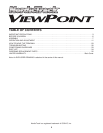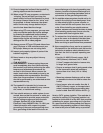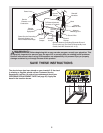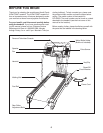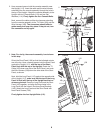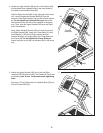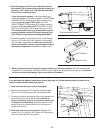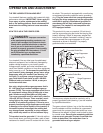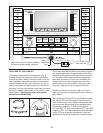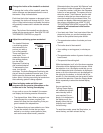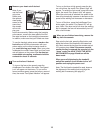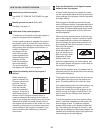
21.
Do not change the incline of the treadmill by
placing objects under the treadmill.
22.
When using iFIT.com programs, an electronic
“chirping” sound will alert you when the
speed and/or incline of the treadmill is about
to change. Always listen for the “chirp” and
be prepared. In some instances, the speed
and/or incline may change before the per-
sonal trainer describes the change.
23. When using iFIT.com programs, you can man-
ually override the speed and incline settings
by pressing the speed and incline buttons.
However, when the next “chirp” is heard, the
speed and/or incline will change to the next
settings of the CD or video program.
24. Always remove iFIT.com CDs and videos from
your CD player or VCR and disconnect your
MP3 player when you are not using them.
25. Inspect and properly tighten all parts of the
treadmill regularly.
26. Never insert or drop any object into any
opening.
27.
DANGER: Always unplug the power
cord immediately after use, before cleaning
the treadmill, and before performing the main-
tenance and adjustment procedures de-
scribed in this manual. Never remove the
motor hood unless instructed to do so by an
authorized service representative. Servicing
other than the procedures in this manual
should be performed by an authorized service
representative only.
28. The treadmill is intended for in-home use
only. Do not use the treadmill in any commer
-
cial, rental, or institutional setting.
29.
If an outside antenna or cable system is con-
nected, be sure that the antenna or cable sys-
tem is grounded to provide some protection
against voltage surges and built-up static
charges. Section 810 of the National
Electrical Code, ANSI/NFPA No. 70-1984, pro-
vides information with respect to proper
grounding of the mast and supporting struc
-
ture, grounding of the lead-in wire to an an-
tenna discharge unit, size of grounding con
-
ductors, location of antenna discharge unit,
connection to grounding electrodes, and re-
quirements for the grounding electrode.
30.
An outside antenna system should not be lo-
cated in the vicinity of overhead power lines
or other electric light or power circuits, or
where it can fall into such power lines or cir-
cuits. When installing an outside antenna
system, extreme care should be taken to keep
from touching such power lines or circuits,
as contact with them might be fatal.
31. To reduce the risk of electric shock, do not re-
move the cover or the back of the television.
There are no user serviceable parts inside.
Refer servicing to qualified service personnel.
32. Upon completion of any service or repairs to
the treadmill or the television, ask the service
technician to perform safety checks to con-
firm that the unit is in proper operating con-
dition.
• Use No. 10 AWG (5.3mm
2
) copper, No. 8
AWG (8.4mm
2
) aluminum, No. 17 AWG
(1.0mm
2
) copper-clad steel or bronze wire,
or larger as a ground wire.
• Secure an antenna lead-in and ground wires
to the house with stand-off insulators
spaced from 4 to 6 feet (1.22 to 1.83m)
apart.
• Mount an antenna discharge unit as close
as possible to where the lead-in enters the
house.
• Use a jumper wire not smaller than No. 6
AWG (13.3mm
2
) copper, or the equivalent
when a separate antenna-grounding elec-
trode is used. See NEC Section 810-21 (j).
Note to CATV system installer: This reminder is
provided to call the CATV system installer’s at-
tention to Article 820-40 of the NEC that provides
guidelines for proper grounding and, in particu-
lar, specifies that the cable ground shall be con-
nected to the grounding system of the building,
as close to the point of cable entry as practical.
4




